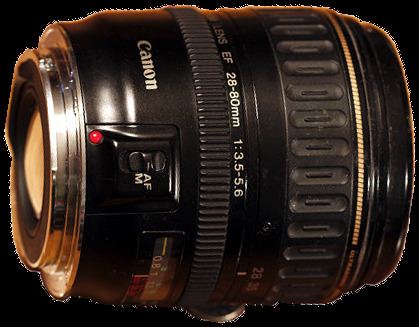 | ||
The EF 28–80mm f/3.5–5.6 is a zoom lens produced by Canon Inc. for their series of EOS single-lens reflex cameras. Canon produced eight iterations of the lens from 1989 to 1999.
The other 28–80mm lens is the Canon EF 28–80mm f/2.8–4L, which was an EF mount wide-to-normal zoom lens introduced by Canon in April 1989. Being of the "L" class, it is of completely different design and structure than the aforementioned 28–80mm f/3.5–5.6 lens.
Description
The 'L' lens is identified by a red stripe round the lens barrel. It is a totally separate classification of lens, much larger and up to three times heavier, sharing very little if any features with the non-L versions. The L version is considerably faster, with an aperture range of f/2.8–4.0 (as opposed to f/3.5–5.6). Unlike newer L-series lenses, it is not a constant aperture lens; the maximum aperture of this lens varied with the zoom (f/2.8 @ 28 mm, f/4.0 @ 80 mm). It uses a ring USM, and as several early professional USM lenses, manual focus is performed with a "focus by wire" arrangement. The manual focus ring is a digital input that directs the lens computer to adjust focus using the autofocus motor. This was done to allow full-time manual focus with the relatively new ultrasonic motors. This lens predates the lower cost, non-L versions and production of this version ended in approximately 1996.
The first iteration of the f/3.5–5.6 ("USM" in the chart below) non-L lens is identified by the metal mounting ring and DoF window. The initial USM version, while much smaller and lighter in weight than the L version, is considerably larger and heavier than later versions due to the internal optics and the use of larger but quieter and faster ring motor USM. Production of the first version ended in (approximately) 1995. This lens is unique in the 28–80 mm f/3.5–5.6 series.
USM versions II through V deleted the DoF window and are considerably lighter in weight and smaller in diameter. They retain the USM feature albeit with a lower-cost, slower but more compact micro-motor version. They share more in appearance with their non-USM siblings, as the body shape and weight are more like the non-USM than the first USM version. The USM II through V versions also incorporate a plastic lens mount.
All USM lenses (including the L version) support full-time manual focusing (FTM), which allows the user to override autofocus simply by turning the focus ring. The USM (ring motor or micromotor) feature is signified by the gold "Ultrasonic Motor" text wrapped around the barrel of the lens on non-L versions. The original lens cap also says "Ultrasonic" although caution is advised as lens caps are often swapped and should not be counted upon as indicative of the actual lens' features.
Lower cost non-USM versions ("Original" and "II" in the chart below) were produced as well. A lower-cost drive system replaced the USM auto-focus system and therefore these lenses do not support FTM. AF action is considerably slower and noisier than USM versions. Lenses such as these without FTM focusing can be damaged if the focus ring is turned by hand while the lens is in the AF mode. Like the USM II-V versions, these non-USM versions have a plastic mounting ring and delete the DoF window.
All variants of the non-L 28–80 mm lens were included at times as kit lenses.
